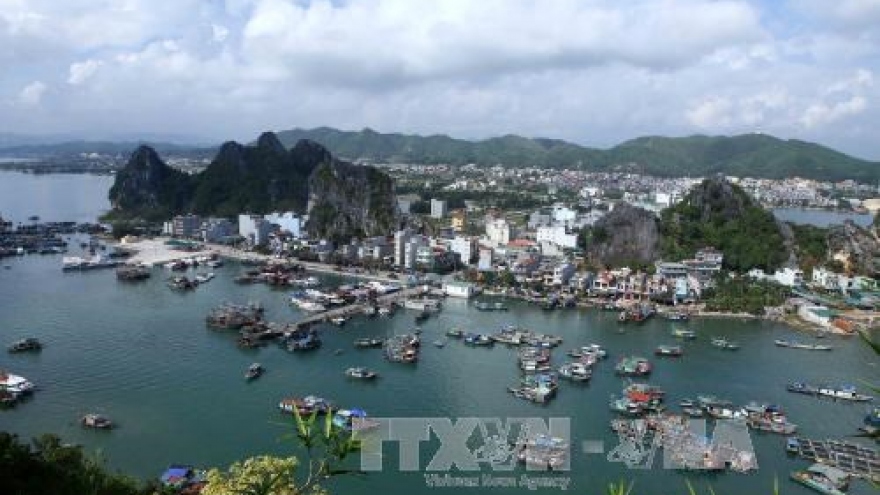Van Don SEZ opens up new opportunities for growth
Owning an international airport not far away from economic-financial centres, as well as famous natural sights in Quang Ninh province, Van Don has outstanding advantages to develop as policies on special administrative-economic zones (SEZ) are being formed.
 |
Natural conditions and infrastructure
Van Don Economic Zone was established by Decision No.120/2007/QD-TTg dated July 26, 2007 of the prime minister. The zone is based on a natural area of 2,171sq.km, including 581 square kilometres of land and 1,589sq.km of water area.
Van Don is in the northern province of Quang Ninh bordering with China. Additionally, it is Vietnam’s most important and active trade gateway towards China and the ASEAN. Quang Ninh has unique advantages for tourism development, such as Bai Tu Long Bay and Halong Bay, which has been listed as one of the natural wonders of the world.
In 2012, Van Don was proposed to become a special administrative-economic zone (SAEZ) along with North Van Phong (Khanh Hoa province) and Phu Quoc (Kien Giang province). Since then, the province has proactively mobilised and attracted resources for infrastructure projects. Particularly, VND20 trillion (US$882 million) was poured into the construction of an international airport, a premium complex services building, and VND40 trillion (US$1.76 billion) into major transport and technical infrastructure works.
Van Don is a corridor between Vietnam and the ASEAN, China, and other East Asian countries. On account of its international airport, it is only two hours from economic-financial-tourism centres such as Nam Ninh, Thuong Hai, Hong Kong, and Macao. Within a five-hour flight radius are three billion people and more than US$22 trillion in regional GDP.
Development orientations
In 2016, the government promulgated Resolution No.103/NQ-CP approving the establishment of three SAEZs. These three will drive the economic development of the country through attracting FDI projects and promoting exports and industrialisation. The SAEZs also create more jobs, build and attract highly-skilled workers, support a wider economic reform strategy, and act as laboratories for the application of new policies and approaches.
Particularly, Van Don SAEZ is oriented to become a green, modern, and smart urban island and dynamic economic center to develop new, advanced sectors focusing on high-end services and tourism, advanced entertainment with casinos, and high-tech industries.
“It will also be the center for startups, innovation, and international trade of the ASEAN-China Economic Corridor. The environmentally friendly development model, streamlined administrative apparatus, institutions, mechanisms, and policies are ready for global competition at the highest level,” Nguyen Manh Tuan, chief of the Quang Ninh Economic Zone Management Authority, informed on the development objectives of Van Don SAEZ at Vietnam Sustainability Forum on January 18.
The key sectors that boost Van Don’s competitiveness and development include tourism, high-technology (with green technology parks, value-added services, R&D parks), and innovative industry.
“If Van Don aims to become a green, sustainable, and knowledge-based city, its incentive policies should target enterprises with a similar mindset, which rely more on knowledge than on natural resources,” emphasised PhD. Prof. Nguyen Duc Khuong, president of the Association of Vietnamese Scientists and Experts and member of the Economic Advisory Board of the Vietnamese prime minister.
Waiting for a mechanism
According to the draft project for establishment, Van Don SAEZ needs around US$12 billion in 2014-2030. Thus, numerous advantages have been raised for investors, such as tax incentives as well as corporate tax reduction or exemption.
The draft law on SAEZs, compiled by the Ministry of Planning and Investment, proposed an exemption from corporate income tax (CIT) for the first four years, then a reduced 50% for the next nine years or a reduced 90% for 30 years. Land tenure is expected to last for 99 years for strategic projects.
The legal and regulatory framework will also facilitate quick and simple investment approval and expatriate work permit issuance. It will also remove import and export licence requirements, accelerate on-site customs inspection procedures, and provide access to automatic foreign exchange.
All delegates at Vietnam Sustainability Forum expressed great hope for Van Don SAEZ, as well as raised some issues on the capacity of the infrastructure and transportation system to meet the huge number of the international visitors. Some concerns related to waste and environmental pollution were also expressed.
The Van Don SAEZ model needs to be made different from other SAEZs. It needs to be given high autonomy, free hand in economic development, and given internationally competitive mechanisms and policies.
The Law on Special Administrative-Economic Zones and the project to establish Van Don SAEZ are expected to be approved by the National Assembly’s May session in 2018.

